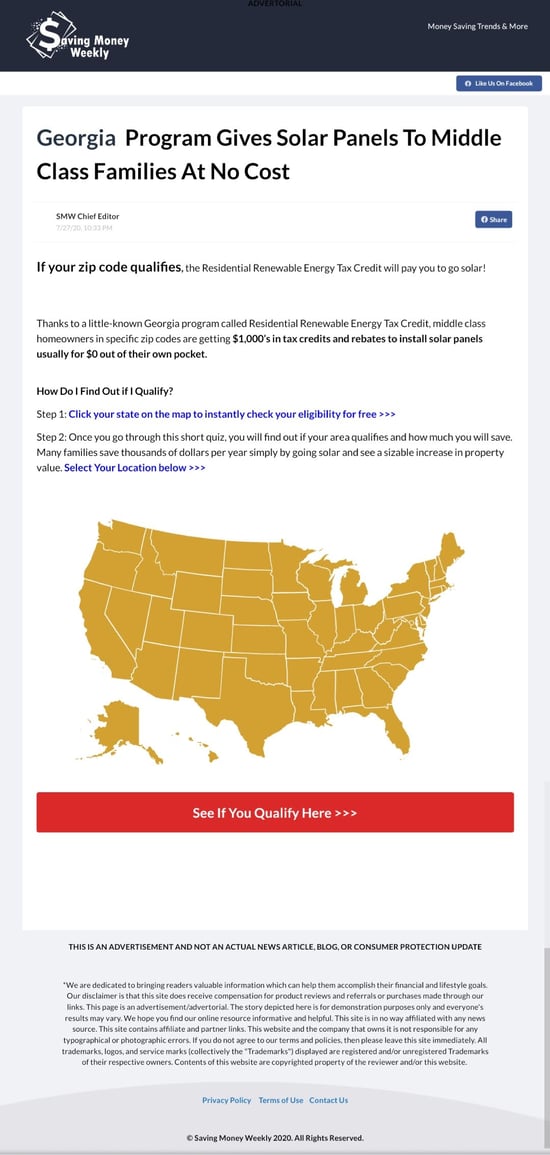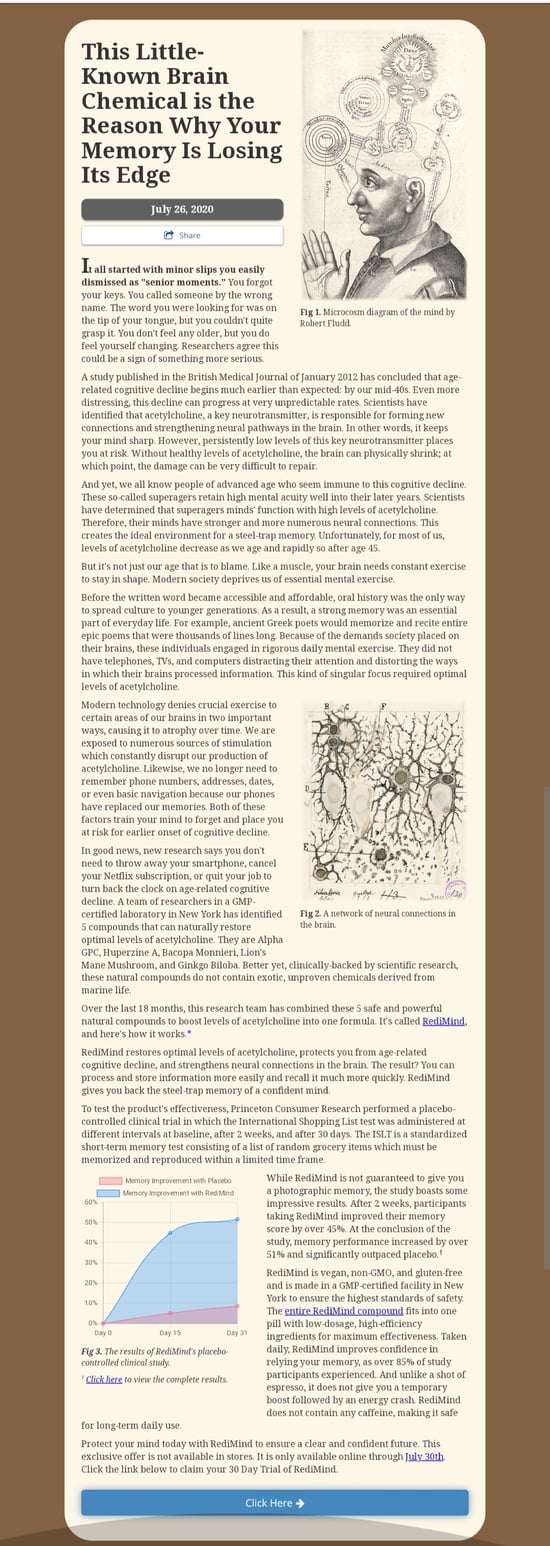Advertorials are marketing hybrids created from the combination of an advertisement and an editorial. The term was coined in the 1960s in the USA from the words' advertisement' and 'editorial.' Basically, advertorials define adverts written in the style of an editorial. They combine the engagement of an editorial article with the information an advertisement presents.
Often disguised as magazine, newspaper, or website content, they look just like the publication's own material, when they are actually paid advertisements. An advertorial, also known as branded content, isn't just an ad, but a carefully told story in a chosen language with the aim of triggering the response of the reader.

Generally, a company pays to deliver a message about their products or brands. The payment is usually made to a magazine, newspaper, or website in exchange for the space required to present a word about a product or brand to the target audience who reads it. When an advertorial resembles the rest of the media, it becomes easy for advertisers to use the connection already established by the media with its readers. This makes it simple to reach customers more directly with an advert message. Although this may sound simple, a properly written advertorial can be particularly useful in attracting new businesses or sponsors.
Why Advertorials Are Great For Business
Advertorials are a unique way of advertising, with a lot of advantages over the traditional methods. Some of them are as follows:
- Effectiveness
Readers are more likely to read an advertorial rather than a conventional advertisement. This is one crucial reason why they work effectively. Author John Caples mentioned in his book Tested Advertising Methods that in 2007, a test was carried out by Reader's Digest to determine the difference in the way consumers perceive a branded content in comparison with a traditional advert. The experiment involved presenting two texts containing the same information, but written in different styles; one as an advertorial and the other as a regular advert. In the end, the branded content sold 81% more products than the traditional advertisement. The results led to the conclusion that advertorials are 500 times more effective than classic adverts.
- Emotional reaction

Advertorials are often written in the form of stories and are capable of creating an emotional response in readers. Well-structured advertorials cause the readers to care, either due to your company background, vision, or the helpful information you've freely provided. It quickly generates response and engagement from them. A reaction of this nature usually establishes a certain kind of connection, making your business more memory.
- More targeted audience
Every business has a specific kind of audience they target, with the liberty to decide which type of publication or online platform they would want to be associated with. This simply means that businesses can choose where their ideal target audience is likely to spend more time. Publishing an advertorial in those publications or online platforms that your target audience is most likely to read gives your business an edge in gaining customers. Because a well-written advertorial often blends in well with the content of the chosen platform, it appeals better to your target audience, thereby increasing the chances of readers converting to business leads and sales. It also increases the awareness and quality of your brand through association with the media outlet.
- Increased Engagement
Branded content are, without a doubt, less obstructive than banners or display ads, and this means that there is a higher chance that consumers interact with them. A lot of studies and reports have shown that advertorials result in more engagement as compared to display ads.
According to a research made by IPG Media Lab, advertorials are likely to receive fifty-two percent more visual focus and provide greater recognition of brands than display ads. A report by Facebook also revealed that advertorials are accountable for up to eighty-six percent of impressions on the Audience Network while getting up to sixty percent engagement than regular display ads.
Nielson carried out another study that showed that branded contents are capable of generating an up to eighty-two percent rise in 'brand lift,' which is a definite shift in customer awareness with a brand. Another importance of advertorials is that they have the potential to gain shares within social media organically, which is something traditional ads simply can't ever do.
- Do not resemble ads
Advertorials don't immediately come off as advertisements since they are introduced as important pieces of information that give the reader an in-depth perspective of the article's subject. This is one of the most significant benefits of using advertorials. In today's setting, consumers are bombarded with marketing regularly. This constant bombardment of advertising has made consumers unresponsive to adverts. Many choose to ignore them altogether.
- No ad blockers
Approximately a quarter of users of internet block advertising, meaning that most ads never even reach intended audiences. In tech-savvy audiences, this percentage is most likely higher. With the rate at which internet users come across advertisements on a daily basis, it is understandable if most people dislike them altogether. Advertorials are great since they aren't technically ads. This way, they can not be restricted by ad blockers. They are embedded directly in the platform and are a great loophole to get past ad blockers. If the rate at which people click your ads is declining, you should opt for advertorials.
- More room to connect with customers
While display ads only introduce a product or brand to consumers, advertorials, on the other hand, provide more room to connect with them. It is possible to tell a story with your business, thereby increasing interest and engagement. Advertorials also allow companies to help customers understand complex products and develop trust by providing value. This goes beyond just asking for sales and always has a good impact on brands. For example, a cloud platform called Service Now published a full-page branded content in Forbes to capture readers' attention, make them understand the technology, give insight on the brand through a story with a case study, and call readers to immediate action. Their advertorial created good awareness and understanding of their service while boosting sales at the same time.
- Less expensive

Advertorials generally don't cost as much as other forms of advertising. Although they may seem a bit costly on certain publications or online portals, you would realize they are still much more cost-effective than spending the same amount of money on other forms of advertising. Smaller online ad platforms often have lesser and reasonable rates for advertorials, depending on their search traffic and branding. Also, with the targeted audience that comes from using advertorials, you would get an overall more effective cost per business lead.
- Better branding
With advertorials, businesses get the chance to advertise their products and services in a way that adds value and usefulness to the reader. In return, the reader perceives your brand in a better light and becomes more interested in wanting to know more about what your business has to offer. This gives your brand a good name and more sales.
- Attracts attention
Advertorials often have a catchy heading with compelling content to attract readers easily. While typical adverts may also appear appealing, the content of advertorials often gives readers reason to keep reading and getting to know more about the product or service. Since branded content are not like typical ads that are made to attract customers by exaggerating products or services, they often appeal to consumers better.
How To Write A Compelling Advertorial
A thoroughly written advertorial can help marketers establish solid connections with their target audiences. However, writing excellent branded content is a delicate act that requires creating a balance between informative and sales content.
Therefore, writing an advertorial requires both advertising skills and editorial skills. It is easy to get carried away by storytelling and forget about the product you're meant to promote. It's also quite easy to end up making an advertorial look too sales-oriented, which is not good either. To achieve advertorial success, follow these tips:
- Research the context
Just as it is essential to research locations and surroundings when designing a billboard, it's also vital to research the platform on which you want your advertorial to be. Studying the media should be one of the first steps you take towards creating an effective advertorial, as it is targeted to the readership of the intended magazine, newspaper, or online portal.

For example, an advertorial that appears on Vogue magazine would be different from branded content that appears on that of Maxim, even though they basically perform the same function. Knowing the magazine's readership will get you better equipped to create an attention-grabbing headline.
Every advertising platform, be it a magazine, newspaper, or website, has a distinct voice, tone and target market. This is the reason why studying how a platform voices its content is vital. You can accomplish this by reading previous issues or articles to determine the tone standard they usually employ. Not only does this help you craft advertorials that look the same way as the rest of the platform, but it also maximizes your chances of your branded content being taken in by the publication. Research is often one of the most undervalued steps in creating advertorials, so don't overlook it.
- Learn more about the audience
A reasonable percentage of Business to Business marketers agree that having a concrete buyers' persona is an essential element in the success of content marketing. In addition to knowing about the tone of the publication, knowing the audience is necessary too. If you don't have a good understanding of the publication's audience, your advertorial most likely won't resonate with them. To understand what the audience thinks, reading through comments, reviews, and forums is an excellent way to start. Doing this helps you gain insight into the readers' questions, concerns, and ideas.
A great tool to use to locate forums is the Google search operator. It gives you access to panels of your choice and is available as a google extension. Reading reviews also come in very handy, as they highlight issues users face with similar products or services and deliver feedback about them. Sites like Amazon are good places to look for reviews on products.
You could also visit social media platforms like Twitter, and search for keywords to relevant discussions. Remember to keep an eye out for trends you see relating to your audience, for any questions or opinions they may have. It is essential to learn how your audience talks about your proposed topic and product because this greatly influences how you create an advertorial.
Have a look at how understanding everything about your target market can benefit you in this post about targeting the biggest spenders online -- the Millenials.
- Don't give a sales pitch
This is another very important tip to keep in mind when writing an advertorial. Even after creating the most captivating headline, if your reader detects it is an advert at the beginning of the article, then your branded content will possibly lose its effect.
Your advertorial is like your Trojan Horse, and your audience shouldn't see an advert coming. Readers often don't want to read an advert but want to learn something interesting. Hard language and hard-hitting pitches at the beginning of your advertorial is not the way to go about it. It often comes off as annoying to most people. This being said, an advertorial should be 70% informative and 30% advertisement. If the goal is awareness, it should shift towards informative content, but if it is leads and sales, then your material should be more promotional.
To achieve the best results from your advertorial, you have to create an intelligent connection with your product or service. You should subtly weave in your specific product a few times in your article to create a well-written advertorial that takes the reader through the article from the headline till the end. Blatant selling language is not advisable because when most readers detect a sudden switch from editorial writing to sales speak, they lose interest and drop out.
- Lead with a compelling headline
The most powerful advertorials begin with a headline that directly speaks to the audience and triggers interest. It's so important that we actually created an article dedicated to creating the perfect native ads headlines!
While choosing a headline, put into consideration the kind of titles the publisher usually writes. For example, Time headlines are factual and straight to the point, while the headlines of articles in Design Milk often include unexpected or emotional words.
The average news consumer reads a headline, and this always determines whether they would go ahead to read the copy or not. Your advertorial headline has to be compelling, exciting, and jarring. Make readers want to read the entire article by giving them something unexpected. A good approach to take is creating a sense of urgency by using words like 'today', 'hurry', 'limited', 'soon', 'secret', or something similar. These words create the feeling of missing out on something great (FOMO).
Another way to create a compelling headline is by asking an interesting question. Most visitors are looking for information on how to solve a specific problem they are encountering, which is why they're reading the content. And you can predict these questions if you study the persona of the audience well enough. Headline analyzers allow you to analyze your headline by giving you helpful information on word length, balance, sentiments, and keywords.
- Write like the publisher

After enough research has been done about how the publication speaks to its readers, it is essential to write like them and make your branded content blend in. Every paper has its voice; for example, Vice is gritty, while The Economist is more on the perceptive side. Different advertising platforms also have their writing styles, which could be in the form of listicles, pictures with a short information, or just a regular article divided into paragraphs.
Writing an advertorial using a similar tone and style allows readers to have a seamless transition from the publisher's content to your advertorial, making them more receptive to a sponsored message. It is advisable to avoid using pronouns like 'we' or 'our' throughout your article, as it often comes across as sales-like rather than helpful.
Some publishers exude a similar tone, for instance Forbes and Business Insider both have a "matter-of-fact" attitude in their articles and like to include references and numbers (which business-enthusiasts appreciate). If such is the case, you can use one advertorial to promote in these publishing websites.
If you're using multiple native ad networks to run one campaign, try using Brax.io. This platform helps you compare the performance of the same campaign across several traffic networks within one dashboard.
- Make the reader feel involved
No matter what format you choose to adapt, give more attention to telling a story through an advertorial, and focus less on making a hard sell. As mentioned previously in this article, a good advertorial shouldn't read like an ad. Feel free to tap into the readers' emotions through the advertorial, such as their surprise, interest, or frustration. During the research, find a successful article from the publisher and adapt its storytelling style. With this, audiences will surely feel engaged in your advertorial, giving your brand a more authentic feel.
Do not make the mistake of focusing on blending a list of required selling points and boring research, when what readers really want, is something that would trigger an emotional response. You should imagine you're writing a piece of content for the publication and make the story not about the product but about the lives of people and how they are made better by the product. Find an interesting aspect of the product or service and use that to create a story while taking your reader through a journey to the inner workings of the company.
A great advertorial reads just like an exciting editorial pick and gives the readers the feeling of wanting to try the product at the end, without ever using the word 'buy.' Creating such a story from testimonials and cases related to the product or service gives a greater ring of authenticity.
- Write a Clear Call to Action towards the Conclusion
An effective branded content should always close off with simple instructions on the next step interested users need to carry out. While a headline is what encourages readers to go through your article, a call to action is what inspires you to make that next move and take action. When you include a strong call to action at the end of your article, it creates a sense of urgency in readers and sometimes renews the interest of undecided users.
A smart move would be to include an incentive or exclusive offer they'd get by signing up through the advertorial. This is very effective for online advertorials. Advertorials generally can also mention simple incentives like an extended free trial or even a free shirt. The call to action must be very specific to the featured brand or product.
Advertorial Examples
To give you further insight about how an advertorial works and how other businesses do it, here are some examples.
For a tax credit offer:

For a brain booster food supplement:

For an e-commerce product:

For a diet product:

Final Thoughts on Branded Content
Advertorials come in different forms, giving marketers endless opportunities to relate to target consumers through the act of storytelling. A creative advertorial can establish a connection between businesses and customers that can't be made possible with other forms of advertising.
Advertorials can be quite effective; however, using them to implement a marketing strategy requires adequate planning and following the practices proven by experienced writers to work. The first step to writing a great branded content always begins with a deep understanding of who the advert targets. It will be much easier to create a relevant and engaging message when you deeply understand who your target audiences are, what they are most likely to respond to, what their issues are, and which publications will likely pick their interest.
Before you begin writing an advertorial, you should create a checklist to ensure you abide by all the important rules and tips. Your list should include an epic headline, a great introduction, relevant stories, information about the product or service, data to back up claims as its important to use proven facts, images, and a call to action. Use your checklist through the whole process of writing to ensure you create a perfect advertorial.
Advertorials of the highest quality begin with a captivating headline and end with a compelling call to action while reflecting the publisher's voice and format through a story that goes beyond a basic sales pitch. In the end, just like every other advertising channel, success depends on creating a balance between the needs of your readers and the value of your business.

